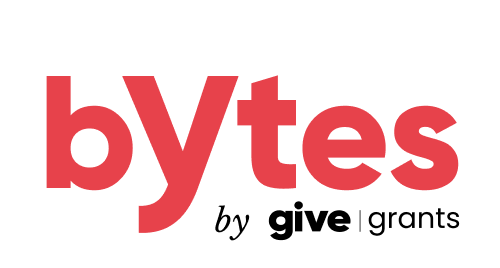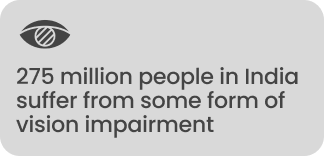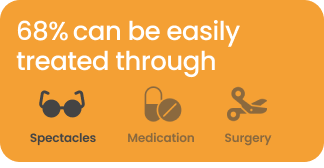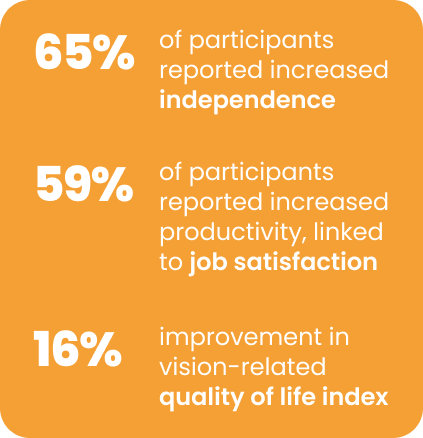

“Bytes: Practical Research for CSR” is a series by Give Grants designed to decode and demystify the extensive social impact research and data available in the form of clear and actionable insights for CSR practitioners in India.”
The financial burden of poor vision is immense. A study published in The Lancet estimates that the annual economic loss due to uncorrected refractive errors is approximately USD 411 billion globally.1 This figure encompasses direct costs such as healthcare expenses for vision problems and indirect costs like lost productivity in the workforce.2
Addressing productivity loss is straightforward and low-cost: a simple vision test and a pair of prescription glasses costing between INR 125 and INR 300 can significantly improve productivity. Studies indicate that correct prescription glasses can enhance precision task productivity by up to 30%.3
The scale of the vision impairment problem
Vision impairment affects a significant portion of the global population, necessitating a greater focus on eye health. Current estimates show that at least 2.2 billion people worldwide, including 275 million in India, suffer from some form of near or distance vision impairment. Alarmingly, half of these cases are preventable. Many vision impairments, particularly those caused by refractive errors, can be effectively corrected with spectacles. However, only 36% of individuals needing spectacles for refractive errors have access to them.
The International Agency for the Prevention of Blindness (IAPB) maintains global data on vision loss. They predict that 68% of vision problems in India could be treated through screening, prescription spectacles, medication, and surgery. These include refractive errors, cataracts, presbyopia, and other age-related vision issues. The remaining 32% involve serious vision losses due to conditions like glaucoma, untreated diabetic retinopathy, trachoma, genetic disorders, and vitamin A deficiencies.


Vision Impairment affects not only quality of
life but also livelihood
Research indicates that moderate-to-severe vision impairment or blindness, especially among the working-age population, reduces employment rates by 30.2%.7 In South Asia, uncorrected refractive errors lead to significant annual productivity losses, estimated between $61.9 billion and $71.2 billion.8
Uncorrected presbyopia, an age-related nearsightedness, significantly impacts productivity and quality of life. It hinders essential economic activities such as reading, writing, and using tools, affecting daily functioning. Studies in China, Africa, and other LMICs show that individuals with uncorrected presbyopia face difficulties in tasks crucial for livelihood, reducing income and job satisfaction. Providing corrective spectacles has been shown to enhance productivity, emphasizing the importance of addressing presbyopia for economic and social well-being.9

Transforming adult lives with prescription
spectacles
Evidence of improved productivity
Numerous studies highlight the significant impact of correcting vision impairments on productivity and economic stability. A University of Michigan paper shows a productivity increase of up to 34% from wearing spectacles. In Rwanda, correcting vision saw a 3x reduction in work errors in coffee bean sorting. In the Indian subcontinent, two randomized controlled trials (RCTs) involving VisionSpring – Project PROSPER and Project THRIVE – in partnership with BRAC have demonstrated the impact of prescription spectacles.
PROSPER, the first-ever RCT to explore the link between clear vision and productivity, involved 750 mainly female workers on tea plantations in Assam. Workers in the intervention group, equipped with corrective eyewear, saw a 21.7% higher productivity (compared to the control group, adjusted for other factors), from 25.0 kg to 34.8 kg daily, translating into higher income. Compliance with wearing study spectacles reached 84.5% by the study’s end.10
The THRIVE trial explored the link between spectacles and income in rural Bangladesh with 3,655 participants aged 35-65 years. It revealed a high presbyopia prevalence, affecting about 50% of participants. Eight months after spectacle distribution, laborers reported a significant 33.4% income increase compared to those without spectacles. Unemployed individuals at the study’s onset experienced higher income boosts, suggesting spectacles facilitated their return to work. With only 35% literacy, the study highlights spectacles’ utility beyond reading, improving tasks like sewing and food preparation. These results underscore the economic benefits of even modest presbyopia treatments like spectacles with a 1D median power.11

Evidence of improved quality of life
A 2016 World Economic Forum report noted that in India, 65% of participants reported increased independence and 59% improved productivity post-correction, highlighting the broad benefits of accessible vision care.12 Another study showed that reading glasses are useful for household tasks like sewing, weaving, preparing food, and storing grain. Wearers experienced a 16% improvement in a near-vision quality of life index, measuring independence and ease of completing daily tasks.13

Additional models for CSR
Beyond the two RCT projects, various models linking vision care and livelihood have existed. With dedicated studies for evidence documentation, these models can be scaled up. Some examples where CSR has provided strategic support as shared below.
Transportation and road safety
The link between poor vision and road accidents is increasingly recognized. Research in India found that drivers with correctable poor vision were up to 30 percentage points more likely to be involved in accidents compared to those with clear vision.14 Sightsavers India’s Raahi project, supported by CSR donors, established eye centers in transport hubs to screen and offer corrective spectacles to truck drivers in India.15
Healthcare Access
Specialty healthcare is often concentrated in urban areas, with rural areas having limited access to ophthalmology services. Essilor International’s teleophthalmology solutions bring eye care to villages, offering checkups and providing corrective spectacles priced at Rs. 250, dispensed in an hour from ready-made stock.16
Additionally, Essilor International trains unemployed youth to become eye care providers called Eye Mitras. A study by Dalberg Global Development Advisors evaluated 400 Eye Mitras serving 70,000 spectacle wearers in Uttar Pradesh. The study estimated an annual impact of US$4.4 million, including increased earnings for Eye Mitras, improved wearer productivity, and increased revenues for rural suppliers and small businesses. Scaling this initiative nationwide could result in a US$487 million annual economic impact.17
References
- Vision impairment and blindness has global economic impact of $411 billion in lost productivity per year
- Global economic productivity losses from vision impairment and blindness | The Lancet
- Eyeglasses for Global Development: Bridging the Visual Divide
- Blindness and vision impairment| WHO Blog
- Presbyopia: prevalence, impact, and interventions
- IAPB Vision Atlas | India
- Vision impairment and blindness has global economic impact of $411 billion in lost productivity per year
- Global economic productivity losses from vision impairment and blindness | The Lancet
- Quality of Life and Near Vision Impairment Due to Functional Presbyopia among Rural Chinese Adults
- Effect of providing near glasses on productivity among rural Indian tea workers with presbyopia (PROSPER)
- The effect on income of providing near vision correction to workers in Bangladesh: THRIVE RCT
- Eyeglasses for Global Development: Bridging the Visual Divide
- The effect on income of providing near vision correction to workers in Bangladesh: THRIVE RCT
- Assessment of Driver Vision Functions in Relation to their Crash Involvement in India
- RAAHI – Serving those that serve us – Sightsavers India
- In the field with Essilor
- Essilor’s Eye Mitra
An infographic depicting the impact of prescription spectacles on productivity, income and quality of life



